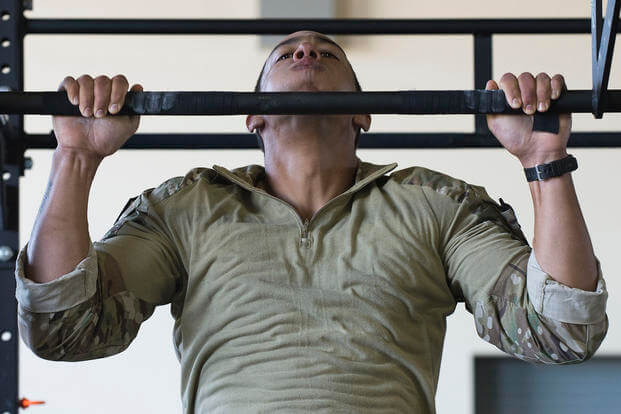There are many options to improve your calisthenics base to prepare for testing. The most common way to make calisthenics tougher is to simply do more repetitions. If actually doing more is the challenge, you may want to get creative with other options.
There are many ways to make calisthenics harder. In fact, the military already uses many of these additional options in fitness tests. If you are seeking ways to improve your calisthenics push-ups, pull-ups, sit-ups, dips, squats, planks and lunges, try these options during your normal workout.
You can give yourself a break from the higher-repetition options of these exercises but still challenge yourself and improve in any area of calisthenics.
Weighted Calisthenics
If you do not want to increase repetitions, you can add weight with either a weight vest, plate carrier, SCUBA diver weight belt or by holding a weight with your hands or legs.
Workout options: Many like to reduce the repetitions by adding weight to their push-ups, pull-ups, dips, planks, squats and lunges. The weight vest workout is a classic and is used by many of our first responders and CrossFit members when doing workouts that include pull-ups and squats. Our local group does a calisthenics- and cardio-based workout called Weight Vest Wednesday or Weight Vest Weekend.
Weight Vest Wednesday Reverse Pyramid
Reverse Pyramid 20-1 (w/weight vest 20-30 pounds)
Sets and reps: 20, 19, 18, 17, 16 reps with short 30-meter run* between each set of the following exercises:
push-ups, plank pose (1 sec = 1 rep)
Sets and reps: 15, 14, 13, 12, 11 reps, with short 30m run between sets
push-ups, abs of choice, dips
Sets and reps: 10, 9, 8, 7, 6 reps (no run)
pull-ups, TRX push-ups or elevated, TRX rollouts or ab wheel
Sets and reps: 5, 4, 3, 2, 1 (no run)
Dips, pull-ups, heavy rows or pulldowns
Run or ruck 30 minutes (ruck with weight vest)
And/or add swimming workout
Swim: 500m warmup
Repeat 5 times
100m free (hypox 6-8 spb)
50m CSS (combat swimmer stroke)
Repeat 5 times
100m choice -- fast
Rest with 50 abs of choice: flutter kicks, leg levers, scissors, etc.
*30m run can be replaced with 20 jumping jacks or 20 jump ropes if you don't have space. We do these on a basketball court.
Test option: There are some units within military special operations and SWAT teams that use the weighted pull-up as a test, because it is a good simulation of the gear worn as body armor/plate carriers.
Cadence calisthenics/testing: There are tests used in the United States military and law enforcement that promote perfectly timed repetitions of exercises like push-ups, pull-ups and squats. The Coast Guard uses cadence push-ups for their entrance candidate fitness assessment test. The other service academies use cadence pull-ups for their candidate fitness assessments as well. Typically, the cadence for testing is two seconds per full repetition. That means one second down and one second up. If you do this test for one minute, that equals 30 repetitions, and a two-minute test is a real challenge to even the fittest members. Sixty perfect push-ups on cadence is an incredibly difficult task.
Cadence workouts: You may be able to do 100 push-ups in two minutes at your own pace, but 60 at this testing pace is a way to work harder with fewer reps during workouts. Both require practice to get better. However, the cadence calisthenics are easy to add to any workout involving calisthenics or weighted exercises, and there are Metronome APPs for that too.
If you want to get better at calisthenics and do more repetitions, check out the PT progression articles -- Part 1 -- PT pyramid, Part 2 -- super set and Part 3 -- max rep set as a way to build muscle stamina. Take these three classics and do them to a cadence or add weight. You can place all three into the Military PT training week, but remember to follow some basic rules and considerations for doing calisthenics, weighted calisthenics or weight lifting to get stronger.
Stew Smith is a former Navy SEAL and fitness author certified as a Strength and Conditioning Specialist (CSCS) with the National Strength and Conditioning Association. Visit his Fitness eBook store if you’re looking to start a workout program to create a healthy lifestyle. Send your fitness questions to stew@stewsmith.com.
Want to Learn More About Military Life?
Whether you're thinking of joining the military, looking for fitness and basic training tips, or keeping up with military life and benefits, Military.com has you covered. Subscribe to Military.com to have military news, updates and resources delivered directly to your inbox.


















